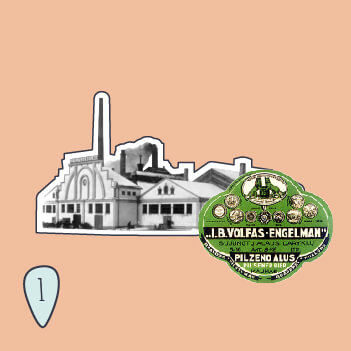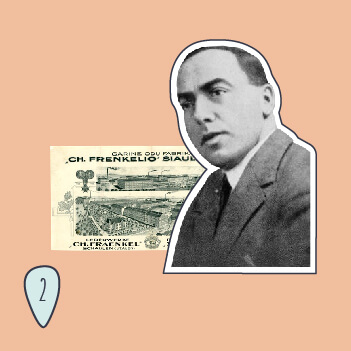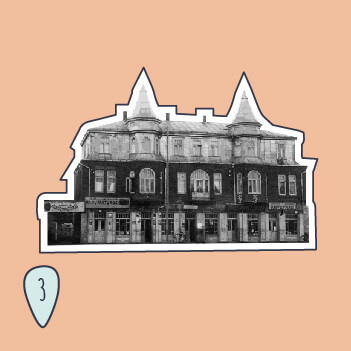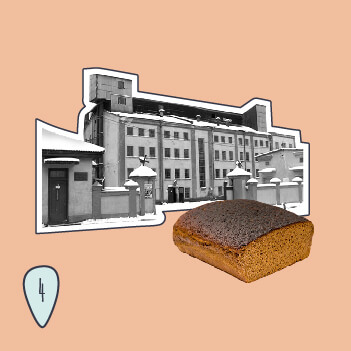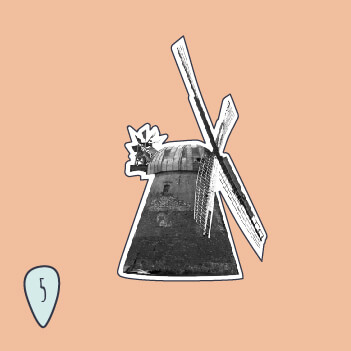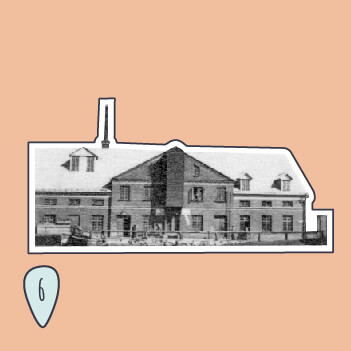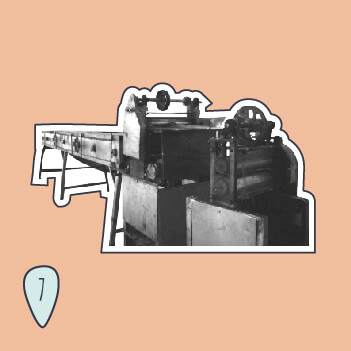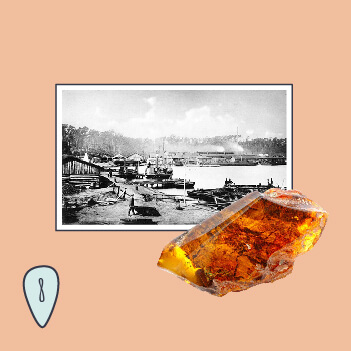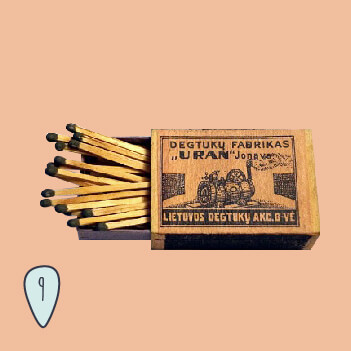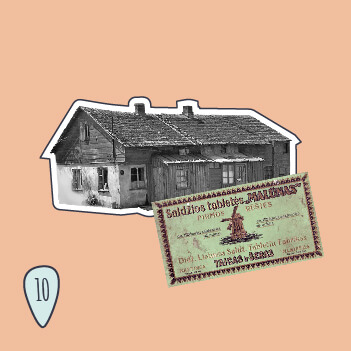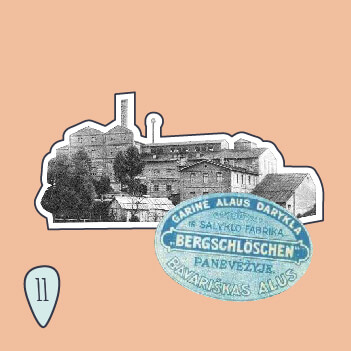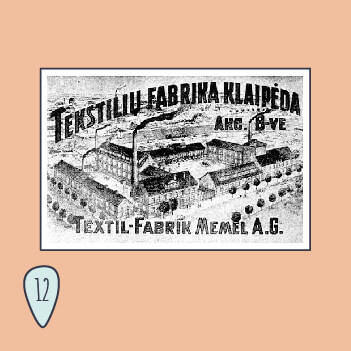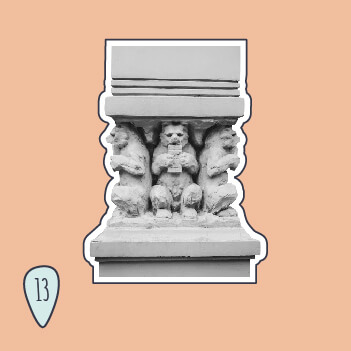Litvak Industrial Heritage
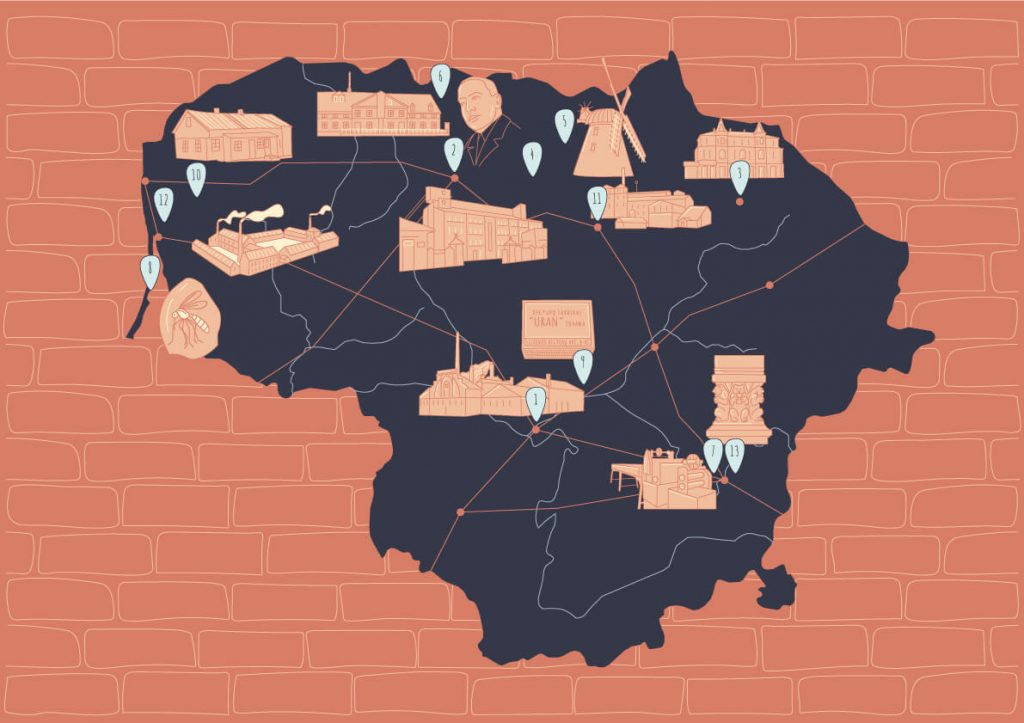
1. “Volfas Engelman” Beer Brewery in Kaunas
One of the oldest industrial enterprises in Lithuania, a brewery, was established in Vilijampolė in 1853 by Rafailas Volfas. It was the first one in the current territory of Lithuania to start using a steam boiler in beer production – at that time it was the most advanced production technology, imported from Germany. In 1860 another brewery, called “Engelman” started operating in Kaunas near the Nemunas and the railway station. This brewery, owned by Ferdinand Engelman, was bought by R. Volfas’ son I. B. Volfas and his friend A. Soloveicikas in 1894. The new proprietors did not change the name of the brewery – both breweries were operating at the same time: “I. B. Volfas” as well as “Engelman”. The brands of these breweries were widely known outside Kaunas province and won medals at international fairs. During the First World War the owners of “I. B. Volfas” and “Engelman” left for Russia. After Lithuania declared independence, they returned to the country and undertook the reconstruction of the burned “Engelman” brewery. In 1927 I. B. Volfas and A. Soloveičikas merged the two companies into the “Joint Stock Company of I. B. Volfas-Engelman of Combined Breweries, Malt Factories and Fruit Workshops” in order to adapt to the difficult market conditions and to increase the profits of the breweries. The company became the largest brewer in the country and at that time accounted for almost 40% of the Lithuanian beer market.
Location: To this day two 19th century red brick factory buildings and two outbuildings remain (Radvilų Dvaro str. 2).
2. Frenkel Leather Factory in Šiauliai
The Frenkel family and their leather factory made a great contribution to the prosperity of Šiauliai. Chaim Frenkel’s (1851-1920) leather processing company, opened in 1887, supplied its customers with high-quality treated leather, which received various awards. The success of the factory was so great that the Frenkel family was able to build a luxurious historicist-style villa next to it. Currently, the villa belongs to the Šiauliai “Aušros” Museum and hosts a permanent exposition “Jewish Heritage in Šiauliai: The Frenkel Merchants”. The Frenkels built a brick synagogue for the factory workers on the site next to the former wooden one. The former building of the house of prayer has survived to this day (Vilniaus str. 68).
Location: A sculpture to Chaim Frenkel was unveiled in front of the factory he founded (Vilniaus str. 49) to honour his contribution to the city’s prosperity. It is also possible to visit the factory buildings, which, although abandoned, have largely survived (Vilniaus str. 72).
3. Zametai and Agricultural Machinery Manufacturing in Rokiškis
During the interwar period, Jews actively developed business in Rokiškis ‒ the vicinity to Latvia presented an excellent opportunity to develop export and import activities. Jews soon established numerous factories and workshops in this crafts and trade hub: to this day, there is a house on Vytauto str. 37 which until the Second World War belonged to Panemunėlis teacher Katelė, who lived with his family on the first floor, and had given up the ground floor to the Jew named Meler, who owned a candy and cardboard factory. The Meler brothers also owned the “London” hotel and this building has survived to this day (Vytauto str. 5). Other business-minded brothers from Rokiškis were I. and Ch. Zametai. In 1928 they established their company “Lietmetalas” in a manor building. The company specialized in the production of agricultural machinery. Thus, the Rokiškis ironware factory “Lietmetalas” and the steam mill are the forerunner of today’s “AB Rokiškio mašinų gamyklos”. It is said that at that time the Zametai brothers were probably the richest people in Rokiškis town, their lavish house stood out in the city and has survived in good condition to this day (Nepriklausomybės sq. 10).
Location: The buidings of the former factory remain in Laisvės str. 19, as well as some of the facilities in Taikos str. 12 and 14.
4. Maizel’s Printing House and Factory in Pakruojis
During the interwar period two important personalities in the industry sector, brothers David and Shlome Maizels, lived in Pakruojis, and thanks to their efforts, the town rapidly gained economic significance in the region. Thanks to the brothers, the first power plant with the then prestigious Škoda electricity generator appeared in the town. The mill and the factory owned by the brothers were built in 1930 in the new part of Pakruojis, about 80 people were employed there, and the flour milled in the mill was claimed to be the best in Pakruojis area. In the central part of Pakruojis, the building of the printing house owned by the brothers (Vytauto Didžiojo str. 59) has survived to this day. Besides being savvy businessmen, the Maizel brothers were also generous to the community ‒ they initiated and financed the opening of the Pakruojis Shtetl Judaica Library.
Location: The Maizel brothers lived in the new part of Pakruojis near the mill. The miller’s factory and the house are still standing on Prof. S. Ušinskio str. 33/35.
5. Kalpokai Mill in Linkuva
In Linkuva, Jews were really keen on innovations. The Kalpokai mill, built in the 19th century, is a good example. At the end of the 19th century, according to the locals, it belonged to Abraham and Enke, the son the daughter of the Jew named Sher, and it has survived to the present day. The red brick building where grain used to be milled, has witnessed two world wars.
Location: Before the First World War, the mill was made of wood, when it burned down, a large brick edifice was built in its place, and it still stands today (Pakruojis district municipality, Linkuva area, Kalpokai village). In 1996 the Kalpokai windmill was included in the Registry of Cultural Heritage and it presently belongs to a company “Kalpokų ūkis”. It has the status of a heritage object, where the remaining authentic technical equipment has been preserved.
6. Mozė Strulis’ Mill in Žagarė
As many as 7 mills operated in Žagarė during the interwar period. One of them was the modern, motorized mill of Mozė Strulis. Its function was important at that time ‒ it provided electricity for the whole town of Žagarė, admittedly, not around the clock, but only until midnight. On the ground and the first floors, grains were ground for flour and animal feed, various groats were made, and near the boiler facility there was a building for dyeing fabric and felting wool. The mill caught flame during the winter fire of 1948 and was severely damaged.
Location: in 1968 the structure of the mill was finally destroyed, and only a part of the main mill building has survived to the present day (Vilniaus str. 62).
7. Matza Baking Machine in Vilnius Choral Synagogue
In the Vilnius Choral Synagogue (Pylimo str. 39), Jews used their special machine to bake matza bread for the celebration of Pesach from 1947 until as late as 1992. Today the machine is still functional, unfortunately, no one uses it anymore, as there are no more people who know how to make matza. The baking process is complicated and requires responsibility, as the dough must be baked fast enough. According to Jewish history, in a hurry to escape from slavery in Egypt, Jewish women were trying to knead the dough for bread so quickly that it did not even have time to rise properly.
Location: This unique and extremely valuable exhibit can be seen on the first floor of the synagogue during visiting hours (Pylimo str. 39), where women gather to pray according to tradition.
8. M. Becker’s Amber Business in Juodkrantė
The development and growth of Juodkrantė settlement was determined by the activities of the amber mining company, which operated in 1860 ‒ 1890. Moritz Becker and his partner founded the company “Stantien & Becker”, which grew into the largest industrial production facility in East Prussia. The reason for the rise of Becker was the trade in industrially extracted amber. The giant company, which employed up to a thousand people in Juodkrantė alone, used diving equipment and many modern technologies to extract amber, and it provided its employees with social and health care services and social security, and sold its goods globally: not only in major European capitals or the United States, but also in China, Japan, Southeast Asia, South America and Egypt.
Location: in Juodkrantė, in 1868, when amber excavation works were already in full motion, M. Becker constructed an impressive wooden villa named “Villa Flora”. Not only the proprietor himself rested here ‒ 25 rooms were rented to families or individuals. The three-storey villa has survived to this day (Kalno str. 7a).
9. Jonava Match Factory
At the beginning of the 19th century, many different wood craftsmen, wheelers and carpenters worked in Jonava. The town gradually became one of Lithuanian forest and wood industry hubs. The first industrial enterprise established in the town was a match factory founded in 1912 by Chaim Levin, Leib Upnick and Exie Weicstein. The factory suffered during the First World War, but in 1919 it was rebuilt by the Swedish company “Uran” and continued its activities. In the interwar period, it was known as “Lietuvos degtukai”, and from 1936 it operated as a branch of “Liepsna”.
Location: After the Second World War, the old match factory was reconstructed and turned into Jonava Furniture Factory (Fabriko str. 3).
10. J. Taicas and E. Šeras’ Enterprises in Kretinga
Jews in Kretinga were engaged in various crafts, trade (mostly amber and agricultural products), but the most famous company of Kretinga between the wars was well known throughout Lithuania under the name “Taicas ir Šeras”. Judelis Taicas and Enikas Šeras together managed the Greater Lithuania candle factory “Švyturys” and the herbal infusions’ factory “Virdulys”, and at the same time also produced saccharin and packaged vegetable oils. One facility was not enough for a business of such a wide manufacturing profile ‒ “Taicas ir Šera”s had two headquarters ‒ in Kretinga itself, at Viešoji sq. 2, in the house where J. Taicas lived, and another branch in Klaipėda ‒ at Turgaus str. 37. Unfortunately, such entrepreneurship was not appreciated by the Soviet government which occupied Lithuania in the 1940s, so the property was nationalized. This was how the story of the most successful interwar business in Kretinga ended ‒ J. Taicas went to Kaunas with his son, feeling disappointed with the changes. After the German occupation of Lithuania in 1941, he and his family were taken to the Vilijampolė ghetto and killed there.
Location: The industrial building of J. Taicas and E. Šeras enterprise, which has survived to this day, is in Birutės str. 16. This is a former outbuilding near the residential house of Enikas Šeras, where he had the candle factory “Švyturys”. In another building next to it, in Birutės str. 16A, the story of the candle factory continued ‒ only without E. Šeras. After his death in 1937 part of his business was taken over by Mauša Kacas and the company was renamed “Taicas, Judelis ir Ko”. M. Kacas moved the candle factory to the adjacent building because it offered a larger space and also established a vegetable oil bottling factory “Kokolynas”.
11. “Kalnapilis”, the Reminder of Chazen Family Business in Panevėžys
The Chazen family, which lived in Panevėžys in the end of the 19th century till the beginning of 20th century contributed a lot to the development of the city’s industry. Leizer Ber Chazen was the first flax merchant in Lithuania. In the middle of the 19th century he established “L.B. Chazen and Sons” flax combing and tow processing factory. The factory was one of the most successful businesses in Panevėžys at that time, and Chazen’s wife Chaja at the same time ran the mill “Varpa” in Smėlynės str. The father’s business was eventually taken over by his sons Yitzhak and Hesel, who were known in Panevėžys not only as entrepreneurs, but also as active public figures. Isaac and Hessel in 1929 also bought the well-running brewery “Kalnapilis” from the German industrialists who founded it in the beginning of the 20th century. This is how the young brothers entered the history of Panevėžys as the biggest industrialists of the city between the wars.
Location: The building of Kalnapilis Brewery (Taikos av. 1), which today stands in the same place and is still successfully operating, is the only heritage object reminiscent of the Chazen family’s role in the industrial life of Panevėžys during the interwar period.
12. The Fainbergs and the Textile Factory “Klaipėda“
In 1925 traders Abraham, Leib, Schmerel and Rafael Fainbergs established a textile factory “Klaipėda“ ‒ the first cotton industry company in Lithuania. It was equipped with what was considered the most modern equipment in Europe at that time. The enterprising family turned their textile factory into the largest factory of this profile in Lithuania and the largest company in Klaipėda. The factory produced high quality woolen and semi-woolen fabrics, cheaper cotton fabrics, woolen materials, and yarns. The products, recognizable from the label adorned with two horses, were sold mainly in Lithuania, to the general population, the army, and the police. The factory’s products were awarded gold medals not only in Lithuania, but also at world exhibitions in Paris and London.
Location: The textile factory “Klaipėda” was sold cheaply in 1939, but the production did not cease even during the Second World War, when the state enterprise “Klaipėda Textile Factory No. 1” operated at the premises. The “Trinyčiai textile factory” started operating in the damaged company’s premises after the war. In 1993 it became a private equity firm, and later it went bankrupt. The former buildings of the company to the west of the Malūnai pond were levelled to the ground in 2008–2009. The remnants of the oldest buildings still remain to the north of the pond. Today, only the former administrative building of the factory at Gluosnių str. 12 reminds visitors of the once huge factory.
13. Bunimowicz Candy and Chocolate Manufactory
At the end of the 19th century Tobias (1871-1938), the son of Israel Bunimowicz, one of the richest merchants in Vilnius, opened a candy and chocolate manufactory, named “Viktorija”, and his father soon joined his business. The factory was built at the intersection of Kaukazo (now Mindaugo) and Ugličo (now Šaltinių) streets and it was a great success ‒ the sweets were repeatedly recognized at international exhibitions, and in 1900 he won the gold medal at the World’s Fair in Paris. So, production grew, before the First World War the factory expanded, two outbuildings were built, and it employed up to 800 workers. Unfortunately, in 1914 a huge fire broke out at “Viktorija” factory, destroying the entire building. There were probably plans to rebuild it, but this was thwarted by the outbreak of the First World War and it was never done.
Location: It was the products made in the Bunimowicz candy factory that were sold at the shop of the same name “Viktorija” (Gedimino av. 2). Today, two beautiful sculptures remind the story of the former shop ‒ one can see two lovely little bears savouring a chocolate bar on the facade of the building.
